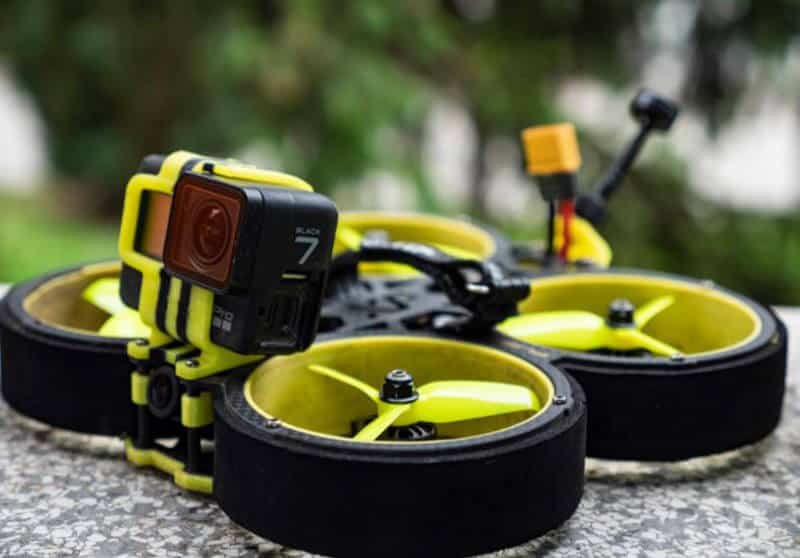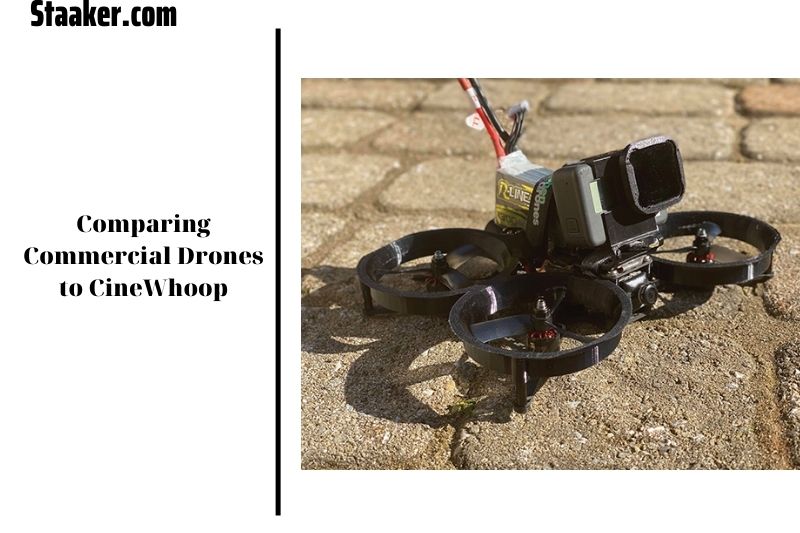What is a Cinewhoop? How to get started with Cinewhoop? And how Cinewhoops compare to Commercial Drones? Check out our article for more information.
Cinewhoops can be used to capture cinematic footage. They can fly safely around people and property, even though they are slow and stable. You can capture stunning, smooth footage with the GoPro’s built-in stabilization (or third-party software). This drone is relatively new and was designed to be smaller and safer in different environments.
What is a Cinewhoop, and who is it for?
Cinewhoops drones are specifically made to capture stable, stable, and high-definition video that DJI drones cannot. They are smaller, more stable, and safer than your 5″ FPV drone. They typically have 3″ propellers, which are protected by ducts to give them more lift*.
Cinematic whoops fly very differently from regular 5″ FPV drones. The power-to-weight ratio is lower. Hover/cruise is around 40% throttle, depending on the HD camera. This leaves little room for corrections or throttle punches.
They fly slowly and steadily, so it’s easy to fly around objects. Because the props are protected, you can fly more confidently around your subject and capture those close-up shots you have always wanted.
Cinewhoop is for anyone who loves slow, smooth footage. Vloggers, filmmakers, and travelers all love Cinewhoops, making their drone footage stand apart from the rest. Cinematic drones can be used as tools, but they are still fun to fly if your preference is cruising.
Cinewhoop Platform Design For FPV
A 3″ ducted drone is compelling for some reasons. First, the ducts. The ducts are more like a bumper than an actual airfoil, but they do not act as ducts. Find out more.
NASA’s research shows that the clearance between the prop and the duct is larger than NASA claims. Although the duct design does not add thrust to an already low-powered drone, it gives an unbeatable advantage over an open prop design in terms of safety.
Although ducts may provide some performance enhancement, they can only be used with custom-made and balanced props. Most BNF options come with a slightly larger than 3-inch duct set. Props must have 0-1% clearance to gain any performance enhancement.
Then why are ducts necessary? The latest designs of the Cinewhoop have foam on the sides to protect the frame and bounce off obstacles. Because they aren’t very fast, these designs make it almost impossible for them to be broken.
Classic duct design
Andy Shen, who created this design with his Shendrones Squirts and TPU ducts, made it very popular. He had an idea to print 3-inch ducts from TPU and cut props to fit these ducts. They were just a little larger than the duct, so the props would be able to dig into the TPU for more thrust.
This design is the foundation of Cinewhoop and offers one of the most exciting platforms for cinematic flying. This design allows the Squirts to be very light and smooth.
The Squirt is not durable. Because the ducts have TPU, it can take hits but also damages the duct. Also, the props fit only barely, so you lose some performance and sometimes break a prop. The second design trend solves this problem.
Read also: https://www.getfpv.com/learn/fpv-essentials/cinewhoop-vs-5-inch-vs-7-inch/
Foam bumper ducts
It is not clear where this design originated, but the earliest design that we could find was the Bumper frame from Armattan Quads. The Bee-Bumper (Frame-Concept) made this design more popular. This design takes the best of the Squirt but improves durability and fun factor. You can bump things and not cause damage.
This is the best option for casual flyers. Designs like these don’t use the duct thrust gains and instead choose a mainstream route. There are currently two BNF options available on the market, but there will be more in the future.
Frame-Concept has partnered with iFlight and gave the BumbleBee its name. The Diatone Tycan is a reworked version of the original design. It improves on the BumbleBee’s gripes, such as the replacement of maintenance arms.
Getting Started
Prebuilt and ready-to-fly CineWhoop packages make it easier to get started. However, it takes practice to fly a CineWhoop. To avoid damaging or crashing your new CineWhoop, you can practice on a simulator before you try it out.
CineWhoops uses custom flight software like FlightOne, EmuFlight, and BetaFlight. These are some of the most widely used FPV flight controller platforms. You can tune your drone to your preference, so you get the best flight experience.
While you can purchase a pre-built CineWhoop, many experienced FPV pilots prefer building their drones. They use components they choose to make the most efficient CineWhoops possible. CineWhoop pilots are still looking for a ShenDrones ShenDrones, or to build their own. The Squirt is the first choice for most pilots who build.
You can also purchase the versions of the most popular companies from their websites. The available drones can be smaller than before and still have the same weight as a GoPro or similar cameras.
However, there is a growing trend to use a stripped-down GoPro camera or similar camera that only uses the lens and motherboard components. This removes the camera’s battery weight and any outer case that keeps it together.
Comparing Commercial Drones to CineWhoop
CineWhoop is smaller than commercial drones and can be positioned almost anywhere you need it to. It can be flown in almost all areas. DJI drones are excellent tools for taking photos and filming outside.
They can also be used indoors to a certain extent but lack the additional capabilities that a CineWhoop offers. Only a handful of commercial drones have safety protection for the propellers. CineWhoop also has this advantage.
Commercial drones come with sensors to keep you from flying too close to objects or subjects. They also have height limits installed legally to ensure that you don’t enter any restricted airspaces.
CineWhoop works entirely manual. Imagine driving an automatic car compared to a manual transmission car. The driver or pilot who operates the vehicle has complete control. Before you can fly a CineWhoop or any other custom-built drone, it is essential to know how to do so.
Are There Any Commercial Drones Made In The US? Click here to know
CineWhoop: Where can I buy one?
A ready-to-fly CineWhoop can be purchased almost anywhere. You can buy ready-to-fly CineWhoop drones from ShenDrones and other stores like iFlight, BetaFPV, DiaTone, Team BlackSheep.
For a slightly higher cost, some packages include the radio transmitter as well as FPV goggles. These companies offer many options for those who don’t want to build one.
All of these drones fly great out of the box. But, what’s more, you can still fine-tune them yourself. You can also take the drone apart to replace or add components.
FAQs Regarding Cinewhoop
What Camera Angles?
A consensus is that the FPV camera should capture 10 to 15 degrees, while the GoPro has a slightly wider FOV.
Read also: Best Drone For GoPro
Which flight type is CineWhoop using?
I switch between Acro and Angle modes depending on the location I’m flying in and how close I am to it.
Acro mode is my preferred mode. Angle mode requires you to constantly fight the self-level, but it works 95% of the time. Flying indoor acro is not difficult, as you transfer your usual skills with a lower angle camera.
To make it less difficult to use angle mode, I lower the angle strength to 20.
What is the weight of a Cinewhoop?
A 3” Cinewhoop with a GoPro typically weighs between 400g and 500g, including a 4S battery of 850mah and GoPro 7.
Conclusion
That’s our guide about Cinewhoop. Hopefully, through this article, you have been able to add more knowledge for yourself and thereby be able to choose the best Cinewhoop that is satisfactory and right for your needs. Thank you for taking the time to visit staaker.com.
See also Flying Tips For Cinematic FPV in this video below:








